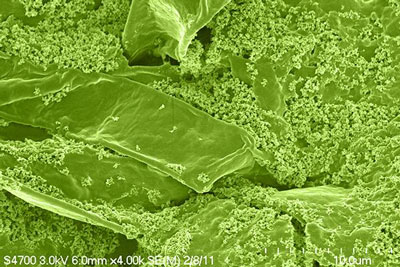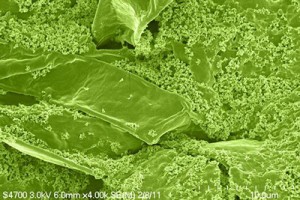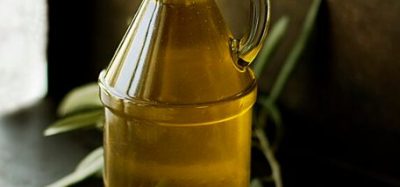Microbe mobilises ‘iron shield’ to block arsenic uptake in rice
- Like
- Digg
- Del
- Tumblr
- VKontakte
- Buffer
- Love This
- Odnoklassniki
- Meneame
- Blogger
- Amazon
- Yahoo Mail
- Gmail
- AOL
- Newsvine
- HackerNews
- Evernote
- MySpace
- Mail.ru
- Viadeo
- Line
- Comments
- Yummly
- SMS
- Viber
- Telegram
- Subscribe
- Skype
- Facebook Messenger
- Kakao
- LiveJournal
- Yammer
- Edgar
- Fintel
- Mix
- Instapaper
- Copy Link
Posted: 16 June 2015 | Victoria White | No comments yet
University of Delaware researchers have discovered a soil microbe that mobilises an “iron shield” to block the uptake of toxic arsenic in rice…


Clumps of bacteria (soil microbe EA106) and iron plaque begin forming on the roots of a rice plant. This "iron shield" blunts the uptake of arsenic. CREDIT: University of Delaware
University of Delaware (UD) researchers have discovered a soil microbe that mobilises an “iron shield” to block the uptake of toxic arsenic in rice.


Clumps of bacteria (soil microbe EA106) and iron plaque begin forming on the roots of a rice plant. This “iron shield” blunts the uptake of arsenic. CREDIT: University of Delaware
Arsenic occurs naturally and it is also used in a variety of industrial products and practices, from wood preservatives, pesticides and fertilisers, to copper smelting. Chronic exposure to arsenic has been linked to cancer, heart disease and diabetes. The new finding gives hope that a natural, low-cost solution – a probiotic for rice plants – may be in sight to protect this global food source from accumulating harmful levels of one of the deadliest poisons on the planet.
The soil microbe the team identified is named “EA106”. The microbe was found among the roots of a North American variety of rice grown commercially in California. It belongs to a group of gram-negative, rod-shaped bacteria called the Pantoea, which form yellowish mucus-like colonies.
Because rice is grown underwater – often in water contaminated with arsenic in such hot spots as Bangladesh, India and China – it takes in 10 times more arsenic than do other cereal grains, such as wheat and oats. As rice plants absorb phosphate, a nutrient needed for growth, they also take up arsenic, which has a similar chemical structure.
EA106 mobilises iron, effectively blocking arsenic’s pathway into the rice plant
“This particular microbe, EA106, is good at mobilising iron, which competes with the arsenic, effectively blocking arsenic’s pathway,” Bais explains. “An iron plaque forms on the surface of the roots that does not allow arsenic to go up into the rice plant.”
The researchers conducted the study with hundreds of rice plants – some grown in soil, others grown hydroponically. Inoculations with EA106 improved the uptake of iron at the plant roots, while reducing the accumulation of toxic arsenic in the plant shoots. While the results are promising, Bais says the next steps in the research will determine if a natural solution to this serious issue is at hand.
“We’re not all the way to the grain level yet. We are working on that now, to see if EA106 prevents arsenic accumulation in the grain. That is the ultimate test,” said Bais.
Fortifying rice plants with iron also increases the grain’s iron content
If the next phase of the research shows success, Bais says inexpensive technologies (think even a cement mixer) exist for coating rice seeds with beneficial bacteria. He also sees an added plus – fortifying rice plants with iron would not only reduce arsenic, but also increase the grain’s iron content as a nutritional benefit.
“I grew up very near to a rice field in India, so I have a different interest in this problem,” Bais says. “Basically, these small farmers don’t have much to feed their families. They grow rice on small plots of land with soil and water contaminated with arsenic, a poison. The work we are doing is important for them, and to the global security of rice.”
In related research, Bais wants to assess the performance of plants inoculated with EA106 when they face multiple stresses, from both arsenic and from rice blast, a fungus that kills an estimated 30% of the world’s rice crop each year. Bais’ group previously isolated a natural bacterium from rice paddy soil that blunts the rice blast fungus. His group is evaluating how a natural alliance between benign microbes and rice can strengthen the plant’s disease resistance.
Both plant threats face rice farmers near his parents’ home in India. Bais plans to start field tests there when he visits with family this summer.
The research is published in the journal Planta.









